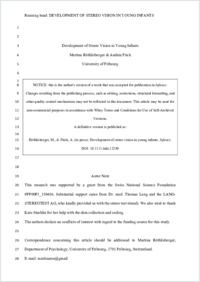Development of stereo vision in young infants
- Röthlisberger, Martina University of Fribourg
- Frick, Andrea University of Fribourg
-
02.08.2020
Published in:
- Infancy. - Wiley. - 2020, p. 1-16
English
In this study, infants’ visual processing of depth-inducing stimuli was tested using a new method suitable for experimental settings. Stereograms of the Lang-Stereopad® were presented in a timed preferential-looking paradigm to determine infants’ preference for a stereogram as compared to a stimulus not inducing an impression of depth. A total of 80 infants were tested at 7 months of age; of these, a sub-sample of 41 infants were tested longitudinally at 4 and 7 months to characterize the developmental trajectory of their preference. Infants were simultaneously presented with a card showing a random-dot stereogram (800” disparity) and a similar-looking dummy card without stereogram. In the total sample, 7-month-olds showed a clear preference for the stereogram regardless of sex. In the longitudinal sample, 7-month- olds but not 4-month-olds looked significantly longer to the stereogram as compared to the dummy card. On individual level, 56% of the 4-month-olds, and 85% of the 7- month-olds predominantly looked at the stereogram. The findings yield evidence for a clear developmental progression, and show that the test cards of the Lang- Stereopad® prototype provide a viable instrument to determine the preference for depth-inducing stimuli in young infants when used in a controlled experimental setting.
- Faculty
- Faculté des lettres et des sciences humaines
- Department
- Département de Psychologie
- Language
-
- English
- Classification
- Psychology
- License
- License undefined
- Identifiers
-
- RERO DOC 328886
- DOI 10.1111/infa.12359
- Persistent URL
- https://folia.unifr.ch/unifr/documents/308842
Statistics
Document views: 82
File downloads:
- rothlisbergerfrick_infancy20_pp.pdf: 304
